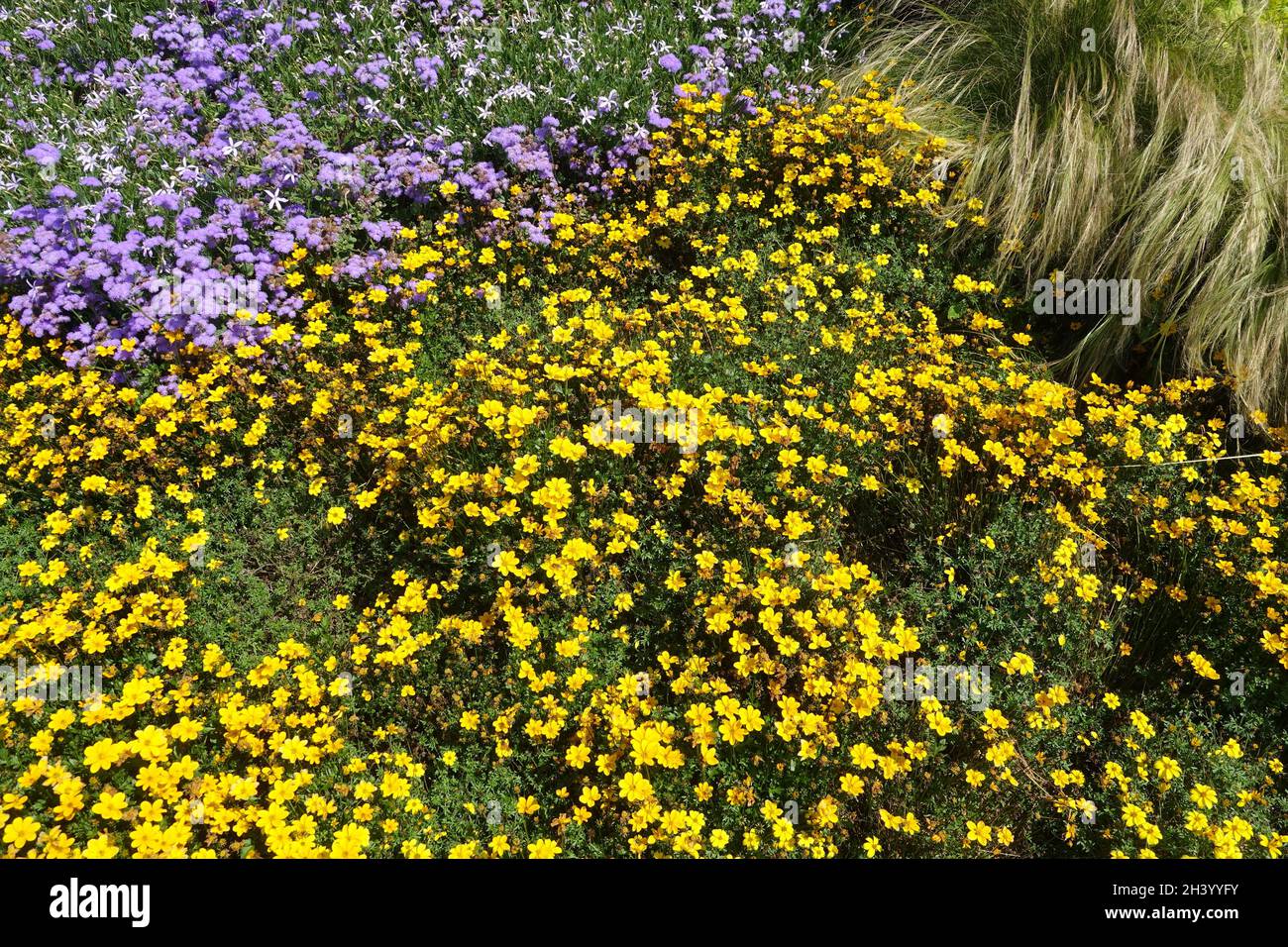Bidens are prolific flowering plants with yellow or orange daisy-like blooms; newer biden varieties have pink, gold, and white blossoms. They are also commonly called Spanish needles, tickseed sunflowers, and beggarticks. They thrive in rich soil with sufficient drainage and require full sun. They tolerate drought and heat relatively well. Bidens are perennial plants in warmer climates. In northern climates with freezing temperatures, they are annuals and will need replanting each year.
Apache beggarticks (Bidens ferulifolia) is a lovely flowering plant that produces bright yellow daisy-like blooms from summer through fall. With its striking flowers and finely cut, fern-like foliage, it’s a great addition to gardens and landscapes If you’re growing apache beggarticks, you likely want to ensure the plants establish properly and thrive. A key factor is planting them at the right depth In this article, we’ll discuss optimal apache beggarticks planting depth and care tips for healthy growth.
Overview of Apache Beggarticks
Native to the southwestern United States and Mexico, apache beggarticks is a herbaceous perennial that typically grows 1-2 feet tall and 1-3 feet wide. The bright green leaves are finely dissected and have a delicate, lacy appearance.
From early summer into fall apache beggarticks produces abundant yellow daisy flowers up to 2 inches wide. The blossoms have a subtle sweet fragrance and attract pollinators like bees and butterflies. After the petals fall, the conspicuous seed heads give rise to the plant’s common name “beggarticks.”
Apache beggarticks thrives in full sun and tolerates heat, drought, and wind once established. It prefers wel-drained soil and needs little care beyond occasional pruning and deadheading spent blooms. Given its toughness and long bloom season, it’s a great choice for borders, rock gardens, and containers.
Optimal Planting Depth
When sowing apache beggarticks seeds or transplanting seedlings, it’s important to plant them at the proper depth for healthy establishment. Here are some key tips:
-
Plant at a depth of 1/8 – 1/4 inches. Apache beggarticks seeds are tiny. Plant them close to the soil surface at a depth of about 1/8 to 1/4 inches. Don’t cover the seeds too deeply.
-
Check seed package instructions. The ideal planting depth may vary slightly depending on the seed cultivar. Follow the instructions on the seed packet for the specific variety you purchased.
-
Use soil as a guide. Plant the seeds at a depth about two times the diameter of the seed. The tiny apache beggarticks seeds should just be lightly pressed into the top of the soil.
-
Give seedlings same depth as containers. When transplanting store-bought seedlings, plant them at the same soil depth as they were growing in the pots. Don’t plant too deeply.
-
Allow for soil settling. After planting, natural soil settling may decrease depth slightly. Account for this by planting seeds and starts a little less deep than the target depth.
-
Firm soil gently. Lightly firm the soil around newly planted seeds/seedlings to remove air pockets. Then water gently to avoid displacing seeds.
Caring for Apache Beggarticks
To keep your apache beggarticks thriving after planting, provide proper care including:
-
Sunlight: Grow in full sun to partial shade. The plants need at least 6 hours of direct sun per day for best growth and flowering.
-
Water: Keep soil consistently moist but not soggy. Water whenever top few inches become dry. Avoid overhead watering.
-
Soil: Grow in moist but well-drained soil. Amend clay soils with compost to improve drainage before planting.
-
Fertilizer: Apply a balanced fertilizer or compost in spring to support growth. Don’t over-fertilize.
-
Maintenance: Deadhead spent blooms to prolong flowering. Prune or cut back leggy growth as needed.
-
Winter care: Mulch plants in fall to protect from hard freezes if growing in zones 8 and below. Cut back foliage after frost.
Troubleshooting Common Problems
Apache beggarticks is relatively trouble-free, but may experience issues like:
-
Poor flowering: This is often due to insufficient sunlight. Move plants or prune overhanging branches to improve light exposure.
-
Leggy growth: Can occur from too much shade or overcrowding. Improve air circulation and cut back stems to stimulate bushy new growth.
-
Leaf spots/discoloration: May indicate fungal disease. Improve air circulation and avoid wetting foliage. Remove affected foliage promptly.
-
Wilting: Can result from underwatering, overwatering, or root damage from pests. Check soil moisture and improve drainage if needed. rule out root problems.
-
Pest damage: Aphids, spider mites, caterpillars may attack. Use insecticidal soap or neem oil and maintain vigor with proper care.
The Right Depth is Key
When planting apache beggarticks, start seeds and seedlings at a shallow depth of about 1/8-1/4 inches. This allows proper germination and establishment. Combine optimal planting depth with proper care like sun exposure, watering, and fertilization. Address any issues promptly to keep your apache beggarticks thriving season after season. With the right start, this tough and long-blooming flower will provide stunning color in your garden for years to come.

How to Grow Bidens From Seed
To propagate by seed, sow the seeds at the end of winter or the beginning of spring. If direct sowing outdoors, wait until after the last frost when temperatures reach at least the 60s.
- Surface sow seeds, only pressing them into the soil. Keep the soil moist.
- Place your seed tray in a sunny location and maintain a temperature of at least 65 degrees Fahrenheit.
- Germination takes about 7 to 20 days.
Water
These plants are considered reasonably drought-resistant. However, they do require regular watering for their best appearance and longevity. An inch of water per week is typically sufficient; water before wilting begins.
The Super Weed You Didn’t Know You Could Eat
FAQ
How deep does a flower bed need to be?
Are beggarticks annual or perennial?
Do Biden flowers need to be deadheaded?
How to keep bidens blooming?
